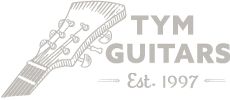1964 Pleasant SEL
Share
Pleasant guitars were another great Japanese brand that shone brightly for a brief period in the early to mid 60's when the pop music boom hit Japan.
The guitars were made by Shinko Gakki who were a very reputable woodworking factory making organs and pianos during the 50's. In the early 60's they started making acoustic guitars and in 1964 started making solid body electrics.
They were branded Pleasant for the domestic market and sold in the US under the Lafayette name. Intermark in New York also imported guitars made in this factory under the Cipher brand name. Other names known to come out of this factory for the US market were Telstar in New York and St George (more on them soon).
Their guitars were heavily influenced by brands like Burns and Eko and had some fantastic original designs like the '66 SEV we have for sale in the shop.
This guitar is typical of the "early" period of Japanese construction and design and although Shinko were relatively late to the party, they worked with Kawai to improve electric guitar design and construction and the differences between this '64 and the '66 SEV are clear to see the leaps and bounds made in two short years.

Shinko were the first Japanese manufacturer to make multi laminated necks which was adopted by some of the big name factories like Kawai and Zen On soon after. This method of construction gives a very strong and stable neck.
The thin solid timber body is "sandwiched" down the middle with a thin laminate top and back, much like the Greco here. It has a Fender offset feel to it but the bottom horn is very Teisco and the shape is very pleasing, or pleasant you might say ...

The neck is a bolt on one piece thick but comfortable piece with a rosewood fretboard. The headstock is pure Fender, which probably makes the body shape seem more "Fenderish"
Shinko used three distinct types of pickups in their guitars and I really like these early square pole piece single coils. They're clear and sharp but with really nice bottom end and warmth to them.
The bridge is a very primitive non intonatable bar much like some Gretsches and other early Japanese guitars but works well and sounds great. The vibrato is fantastic. A lot like the one used on the Honey in design but a little more industrial looking.
This guitar is all original (except one tuner bush) with all the electrics and hardware working in great condition. Again, for a guitar this age that has been played, that's a great sign of quality.
Lots of these types of guitars were trashed during the years when they were looked at as being "cheap Asian guitars" which they are compared to high end US and UK made guitars, but they have a real charm and show that they were well made and designed. Within a couple of years most of the big Japanese factories had improved quality greatly and by the mid to late 70's were making guitars of comparable, or better quality to the guitars they started out trying to copy.

The 50's Japanese production can be very clunky and sometimes frustrating in standard form but even they were well made and good examples still around have proven they were of a standard in construction much higher than current "cheap Asian guitars".
By the early 60's they were really working out how to make some pretty nice stuff and as most of the big factories and brands actually worked together in a genuine attempt to make better and better quality guitars, in a few short years they were really moving forward in design and quality.
Shinko would close in '66 and be absorbed into Kawai who were one of the last "big name" factories to survive the crash in '66/67 and eventually take over Teisco as well. Finding nice examples of these guitars is always a joy for me. When you've owned and played as many guitars as I have you can see the evolution of Japanese manufacturing and I find it fascinating. They were genuinely striving to make excellent products and guitars like this are a prime example of how something very ... basic, can still play and sound so good 55 years later.








